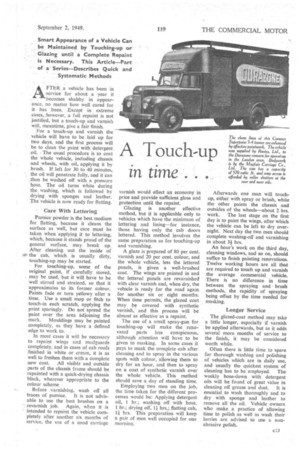A Touch-up in time
Page 51

If you've noticed an error in this article please click here to report it so we can fix it.
AFTER a vehicle has been in . ,service for about a year it becomes shabby in appearance, no matter how well cared for it has been. Except in extreme
• cases,., however, a full repaint is not justified, but a touch-up and varnish will, meantime, give a fair finish.
For a touch-up and varnish the vehicle will have to be laid up for two days, and the first process will be to clean the paint with detergent oil. The usual procedure is to coat the whole vehicle, including chassis and wheels, with oil, applying it by brush. If left for 30 to 40 minutes, . the oil will penetrate fully, and it can ,then be washed off with a pressure hose. The oil turns white during the washing, which is followed by drying with sponges and leather. The vehicle is now ready for flatting.
Care With Lettering Pumice powder is the best medium for flatting, because it cleans the surface as well, but care must be taken when applying it to lettering, which, because it stands proud of the general surface, may. break up. After cleaning out the inside of
5e, the cab, which is usually dirty, touching-up may be started.
For touching-up, some of the original paint, if carefully stored, . may be used, but it will have to be well stirred and strained, so that it approximates to its former colour. Paints fade or turn yellowy after a time. Use a small mop or fitch to touch-in each scratch, applying the paint sparingly. Do not spread the paint over the area adjoining the mark. Mouldings may be painted completely, as they have a defined edge to work to.
In most cases it will be necessary to repaint wings and mudguards completely, and in cases of cab roofs finished in white or cream, it is as well to freshen them with a complete new coat. All visible and outside parts of the chassis frame should be repainted with a quick-drying chassis black, wherever appropriate to the colour scheme Before varnishing, wash off all
traces of pumice. It is not advisable to use the best brushes on a revamish job. Again, when it is ' intended to repaint the vehicle completely after another six months of service, the use of a good carriage
varnish would effect an economy in price and provide sufficient gloss and protection until the repaint.
Glazing is another effective method, but it is applicable only to vehicles which have the minimum of lettering and lining—for instance, those having only the cab doors lettered. This method involves the same preparation as for touching-up and varnishing.
A glaze is prepared of 80 per cent. varnish and 20 per cent. colour, and the whole vehicle, less the lettered panels, is given a well-brushed coat. The wings are painted in and the lettered panels are revarnished with clear varnish and, when dry, the vehicle is ready for the road again for another six or eight months. When time permits, the glazed coat may be covered with synthetic varnish; and this process will be almost as effective as a repaint.
The use of a small spray-gun for touching-up will make the renovated parts less conspicuous, although attention will have to be given to masking. In some cases it pays to mask the complete cab after cleaning and to spray in the various spots with colour, allowing them to dry for an hour, and then to spray on a coat of synthetic varnish over the whole vehicle. This method should save a day of standing time.
Employing two men on the job, the time taken for the different processes would be Applying detergent oil, 1 hr.; washing off with hose, I hr.; drying off, 11hrs.; flatting cab, 14 hrs. This preparation will keep a pair of men well occupied for one morning. Afterwards one man will touchup, either with spray or brush, while the other paints the chassis and outsides of the wheels—about 2 hrs. work. The last stage on the first day is to paint the wings, after which the vehicle can be left to dry overnight. Next day the two men should complete washing-off and varnishing in about 34 hrs.
An hour's work on the third day, cleaning windows, and so on, should suffice to finish painting renovations. Twelve working hours are all that are required to touch up and varnish the average commercial vehicle. There is no difference in time between the spraying and brush methods, the rapidity of spraying being offset by the time needed for masking.
Longer Service The glazed-coat method may take a little longer, especially if varnish be applied afterwards, but as it adds several more months of service to the finish, it may be considered worth while.
Often there is little time to spare for thorough washing and polishing of vehicles which are in daily use, and usually the quickest system of cleaning has to be employed. The weekly hose-down with detergent oils will be found of great value in cleaning off grease and dust. It is essential to wash thoroughly and to dry with sponge and leather to remove all the oil. Vehicle owners who make a practice of allowing time to polish as well as wash their lorries are advised to use a nonabrasive polish.




























































































